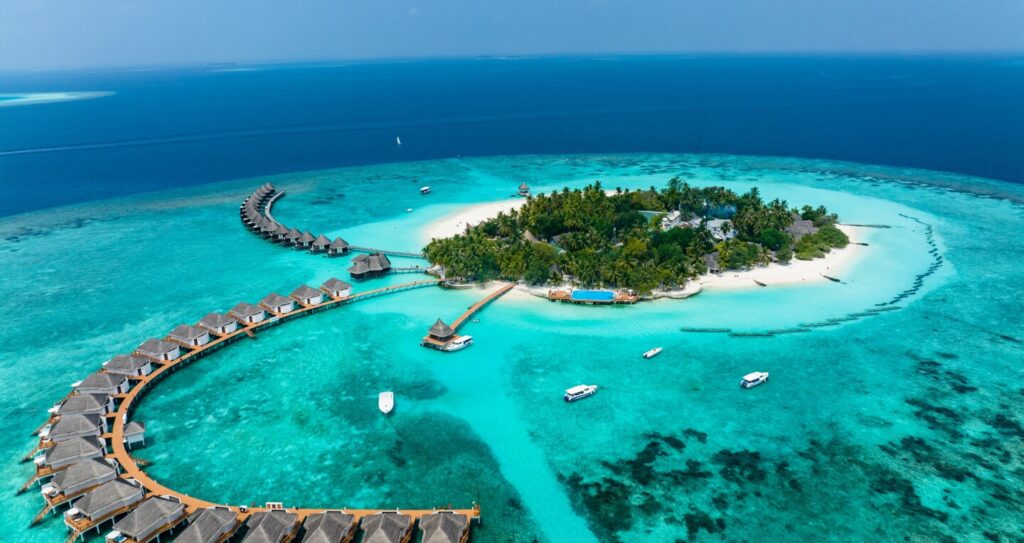Welcome to the tropical paradise of the Maldives, where white sandy beaches meet crystal clear waters teeming with vibrant marine life. This small island nation has been making big waves in the world of tourism, setting a new record for visa-free travel with a staggering 1.8 million new tourists flocking to its shores. Let’s dive into how this Indian Ocean gem is outshining its Seychellois counterpart and what it means for both the economy and local communities.
The growth of tourism in the Maldives
The Maldives, known for its pristine beaches and vibrant marine life, has seen a remarkable growth in tourism over the past few years. With its crystal-clear waters and luxurious resorts, more and more international tourists are choosing this tropical paradise as their ultimate holiday destination. The increase in direct flights to the Maldives from major cities around the world has made it more accessible to travelers seeking a slice of paradise.
The country’s visa-free travel policy for visitors from many countries has also played a significant role in attracting tourists. This hassle-free entry process has made it easier for travelers to explore the beauty of the Maldives without bureaucratic hurdles. Additionally, the promotion of sustainable tourism practices by local authorities has resonated well with eco-conscious travelers who seek responsible travel experiences.
As a result of these efforts, the Maldives has emerged as one of the top destinations for luxury travel and romantic getaways. The growth in tourism not only benefits the economy but also provides employment opportunities for locals in various sectors such as hospitality, transportation, and conservation.
Comparison with Seychelles’ tourism industry
When it comes to tropical paradises in the Indian Ocean, both the Maldives and Seychelles stand out for their breathtaking beauty and luxurious resorts. However, in recent years, the Maldives has been setting itself apart as a top tourist destination with its visa-free travel policy attracting an influx of international tourists.
Seychelles, on the other hand, has long been renowned for its pristine beaches and unique biodiversity. While both destinations offer exclusive island getaways, the Maldives’ strategic marketing efforts have propelled it ahead in terms of visitor numbers.
With over 1.8 million new tourists flocking to the Maldives recently compared to Seychelles’ figures, it’s clear that travelers are increasingly choosing this enchanting archipelago for their holiday adventures. The competition between these two idyllic destinations continues to drive innovation and development within their respective tourism industries.
Factors contributing to the increase in tourists
The increase in tourists visiting the Maldives can be attributed to several key factors. One significant factor is the country’s strategic marketing efforts that have effectively showcased its pristine beaches, crystal-clear waters, and luxurious resorts to a global audience. The Maldives’ visa-free travel policy has also played a crucial role in attracting international visitors who seek hassle-free vacations.
Furthermore, the government’s initiatives to promote sustainable tourism practices have resonated with eco-conscious travelers looking for responsible destinations. The introduction of new direct flight routes connecting major cities around the world to the Maldives has made it more accessible and convenient for tourists to visit this tropical paradise.
Additionally, the diverse range of activities available in the Maldives, from water sports and diving excursions to relaxing spa treatments and romantic beach dinners, cater to a wide spectrum of traveler preferences. This variety ensures that there is something for everyone on these idyllic islands.
Impact on the economy and local communities
The surge in international tourists flocking to the Maldives has not only brought a boom in the tourism industry but also significantly impacted the local economy and communities. The influx of visitors has created job opportunities across various sectors, from hospitality to transportation, supporting the livelihoods of many locals.
As more tourists explore the picturesque islands, there is a growing demand for locally sourced products and services, benefitting small businesses and artisans. This trend fosters economic growth beyond just luxury resorts, spreading prosperity throughout the archipelago.
Furthermore, increased tourism revenue contributes to infrastructure development and environmental conservation efforts in the Maldives. Local initiatives focusing on sustainability and eco-friendly practices have gained momentum due to heightened awareness among both visitors and residents.
The symbiotic relationship between tourism growth and community welfare underscores the significance of striking a balance between economic prosperity and preserving cultural heritage in this tropical paradise.
Challenges faced by the Maldives in sustaining this growth
As the Maldives experiences a surge in international tourists, challenges arise in sustaining this growth. One of the major hurdles is environmental sustainability. The delicate ecosystem of the islands faces strain from increased visitor numbers and development activities. Preserving the pristine beauty of the coral reefs and marine life requires careful planning and regulations.
Infrastructure development to support tourism also poses a challenge. Balancing modern amenities with preserving the unique charm of the Maldivian islands is crucial to maintain their appeal to visitors while protecting their natural resources.
Furthermore, ensuring that local communities benefit from tourism revenue is essential for long-term success. Empowering locals through job opportunities and sustainable practices can help mitigate negative impacts on culture and traditions.
Addressing these challenges will be vital for the Maldives to continue thriving as a top tourist destination while safeguarding its environment and heritage for future generations to enjoy.
Future predictions for tourism in the Maldives
As the Maldives continues to attract a record number of international tourists, the future looks promising for its tourism industry. With its pristine beaches, crystal-clear waters, and luxurious resorts, the Maldives is poised to maintain its position as a top destination for travelers seeking paradise on earth.
The government’s efforts to promote sustainable tourism practices will likely appeal to eco-conscious travelers looking for responsible travel options. Additionally, emerging markets in Asia and Europe are showing increasing interest in visiting the Maldives, further boosting tourist numbers in the coming years.
Advancements in technology and social media platforms will play a crucial role in marketing the Maldives as a must-visit destination. Influencers sharing their experiences on Instagram and YouTube will continue to drive curiosity and wanderlust among potential visitors worldwide.
With strategic investments in infrastructure and hospitality services, coupled with innovative marketing strategies, the Maldives is set to solidify its reputation as a premier luxury travel destination for years to come.
Conclusion: Is it sustainable?
As the Maldives celebrates its record-breaking achievement of welcoming 1.8 million new tourists with visa-free travel, surpassing Seychelles in visitor numbers, there is a sense of triumph and optimism in the air. The growth of tourism has undoubtedly brought economic prosperity to the nation and local communities, boosting employment opportunities and infrastructure development.
However, as this island paradise continues to attract international tourists in large numbers, it also faces challenges such as environmental sustainability, over-tourism concerns, and balancing economic gains with preserving its natural beauty. It will be crucial for the Maldives to implement sustainable practices that protect its fragile ecosystem while catering to the demands of an ever-growing tourism industry.
Looking ahead, the future of tourism in the Maldives seems promising yet complex. With careful planning, innovative strategies, and a strong commitment to sustainable tourism practices, the Maldives can strive towards long-term success while preserving its unique charm for generations to come.
In conclusion: The rise of visa-free travel and increasing tourist arrivals have significantly boosted the Maldives’ economy and placed it on the global tourism map. However; sustaining this growth will require a delicate balance between economic development and environmental preservation – a challenge that must be met with foresight; creativity; and a deep appreciation for this stunning destination’s natural wonders.
Stay tuned to QAWire for more


